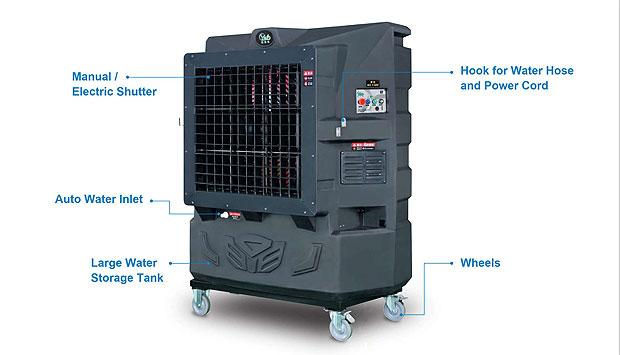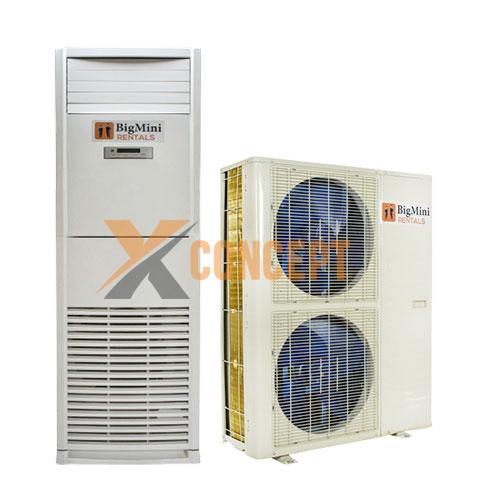Recommended Products
- DetailsQuick View
Specifications: |
|---|
| Voltage/Frequency: | 220V/50HZ |
| Airflow: | 25000 m3/h- 14714 CFM |
| Power: | 1/2HP |
| Cooling Area: | 250 m2 |
| Fan Type: | Axial |
| Water Tank Capacity: | 170 L |
| Fan Blade: | 30″ 3 nos. Nylon6 + Fiber |
| Dimensions: | 1720*1320*690 mm |
| Net Weight: | 100 Kgs |
| Speed (Max.): | 1050RPM (Variable) |
- DetailsQuick View
Specification:
| Cooling Capacity: | 60000 BTU |
| Voltage: | 380~415V/50Hz |
| Phase: | 3 Phases |
| Operating Temperature: | up to 60 Celsius |
| Cooling Area: | 50 to 70 m2 |
| Power: | 7500 watt |
| Amp: | 18 amps |
- DetailsQuick View
Specifications: |
|---|
| Voltage/Frequency: | 220V/50HZ |
| Airflow: | 18000 m3/h |
| Power: | 1100 Watt |
| Cooling Area: | 75-100 m2 |
| Fan Type: | Centrifugal |
| Water Tank Capacity: | 40 L |
| Fan Blade: | 3 speeds |
| Dimensions: | 950x1100x1100 mm |
- DetailsQuick View
Specifications: |
|---|
| Voltage/Frequency: | 220V/50HZ |
| Airflow: | 24000 m3/h |
| Power: | 1100 Watt |
| Cooling Area: | 150-200 m2 |
| Fan Type: | Axial |
| Water Tank Capacity: | 96 L |
| Fan Speed: | 3 speeds |
| Dimensions: | 1120x700x1650 mm |
| Net Weight: | 69 Kgs |
| Swing: | Auto function, left to right |
Warehouse, Factories, Garages Cooling
Warehouses are an important element of the modern economy. For building managers and engineers, warehouses can pose serious HVAC challenges because of their size and unique design, especially when it comes to cooling. Here are five cooling problems that occur frequently in warehouses and tips to solve them.1. Keeping People in the Building Sufficiently Cool
Human comfort and safety should be the number one concern for facility managers who are responsible for warehouses with a workforce of people inside of them. Thousands of employees in the United Arab Emirates fall victim to heat-related ailments every year, even though these issues are preventable. One way to tell if your warehouse is too hot is by referencing the USA occupational safety and health administration heat index. This index provides a temperature scale for when workers need to be prepared for elevated heat levels. It also helps employers plan rest schedules and calculate work rates when employees are working in hot environments.2. Doors Frequently Opening and Closing
Most warehouses need to accept deliveries or send out shipments multiple times a day, which exposes the warehouse to the outdoor climate. This problem is compounded by the large size of open bays, which means they allow more air to escape than a normal door while open. One way to combat this issue is to create a more even distribution of air inside of the warehouse using EVAPORATIVE COOLING MACHINES. When air temperature is more evenly distributed throughout the space, it means the temperature inside of the warehouse is affected less by doors opening and closing.3. High Ceilings Make Air Distribution Difficult
Where residential and commercial office buildings usually have ceilings of around 3m to 5 32, an average warehouse could have ceilings as high as 8m or 12m. As the day progresses, the air in a warehouse continues to heat up, which raises the temperature. To solve this problem you need a method of moving high volumes of air to de-stratify the thermal layers that occur as a result of heat building up at the high ceilings. This helps distribute cool air throughout the entire building to keep the temperature cooler everywhere.4. Indoor Air Quality is harder to Control
Because of the large space and air distribution challenges of warehouses, hot air tends to stagnate throughout the building. Additionally, many warehouses serve as manufacturing or processing centers where employees use chemicals that get mixed into hot air. These circumstances lead to a reduced quality of air throughout the warehouse. If left unchecked, this reduction in air quality can lead to serious problems including sick building syndrome (SBS) . This condition causes coughing, dizziness, irritation and discomfort for occupants of the building. Our expert team has estimated that up to 30% of new and remodeled buildings could suffer from SBS.To solve indoor air quality (IAQ) problems within your warehouse, Our Team advises that you have proper ventilation and air distribution systems in place.5. Keeping Energy Costs Down can be Challenging
Warehouses have larger areas to cool, which means larger cooling systems that take up more room and use more energy. If you aren 19t careful, you may find that your warehouse 19s energy costs start to spiral out of control, especially when the weather is at its warmest. To solve this problem, you will want to take stock of all of the components of your cooling system and analyze them based on energy consumption. Look for cooling solutions that can help you with cooling with low power consumption like industrial evaporative cooling machine.



